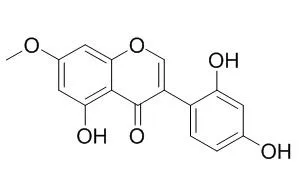| Description: |
Cajanin has potential hypolipidemic effects,possibly via up-regulating the ABCA1 protein expression,subsequently resulting in increased macrophage cholesterol efflux and RCT, it can significantly improve basal glucose uptake in HepG2 cells, its improving effect is concentration dependent, it exhibits effects stronger than that of rosiglitazone, which has been used as an antidiabetic drug. Cajanin has strong mitogenic as well as differentiation-promoting effects on osteoblasts that involved subsequent activation of MEK-Erk and Akt pathways. |
| Targets: |
MEK | ERK | Akt | ABCA1 |
| In vitro: |
| Planta Med. 2010 Jan;76(1):79-81. | | Flavonoids and isoflavonoids from Sophorae Flos improve glucose uptake in vitro.[Pubmed: 19637114 ] |
METHODS AND RESULTS:
Glucose uptake assay-guided fractionations on the methanol extract of Sophorae Flos led to the isolation of the flavonoids rutin (1), narcissin (2), quercetin (3), tamarixetin (4), and kaempferol (5) and the isoflavonoids Cajanin (6), genistein (7), orobol (8), and pratensein (9). Among them, 1, 4, 5, 6, 8, and 9 significantly improved basal glucose uptake in HepG2 cells. Their improving effects were concentration dependent. Compounds 4, 5, 6, and 9 exhibited effects stronger than that of rosiglitazone, which has been used as an antidiabetic drug. However, 2, 3, and 7 did not show any improving effects. Stimulating glucose uptake into peripheral cells may be responsible for reducing the level of blood glucose in the circulation.
CONCLUSIONS:
Therefore, these findings demonstrate a potential to develop these flavonoids and isoflavonoids as hypoglycemic drugs. |
|
| In vivo: |
| J Cell Biochem. 2009 Oct 1;108(2):388-99. | | Methoxylated isoflavones, cajanin and isoformononetin, have non-estrogenic bone forming effect via differential mitogen activated protein kinase (MAPK) signaling.[Pubmed: 19598169] | Following a lead obtained from stem-bark extract of Butea monosperma, two structurally related methoxyisoflavones; Cajanin and isoformononetin were studied for their effects in osteoblasts.
METHODS AND RESULTS:
Cajanin had strong mitogenic as well as differentiation-promoting effects on osteoblasts that involved subsequent activation of MEK-Erk and Akt pathways. On the other hand, isoformononetin exhibited potent anti-apoptotic effect in addition to promoting osteoblast differentiation that involved parallel activation of MEK-Erk and Akt pathways. Unlike genistein or daidzein, none of these two compounds appear to act via estrogen receptors in osteoblast. Once daily oral (by gavage) treatment for 30 consecutive days was given to recently weaned female Sprague-Dawley rats with each of these compounds at 10.0 mg kg(-1) day(-1) dose. Cajanin increased bone mineral density (BMD) at all skeletal sites studied, bone biomechanical strength, mineral apposition rate (MAR) and bone formation rate (BFR), compared with control. BMD levels at various anatomic positions were also increased with isoformononetin compared with control however, its effect was less potent than Cajanin. Isoformononetin had no effect on the parameters of bone biomechanical strength although it enhanced MAR and BFR compared with control. Isoformononetin had very mild uterotrophic effect, whereas Cajanin was devoid of any such effect.
CONCLUSIONS:
Our data suggest that Cajanin is more potent than isoformononetin in accelerating peak bone mass achievement. To the best of our knowledge, this work represents the first attempt to elucidate structure-activity relationship between the two methoxylated isoflavones regarding their effects in osteoblasts and bone formation. |
|






 Cell. 2018 Jan 11;172(1-2):249-261.e12. doi: 10.1016/j.cell.2017.12.019.IF=36.216(2019)
Cell. 2018 Jan 11;172(1-2):249-261.e12. doi: 10.1016/j.cell.2017.12.019.IF=36.216(2019) Cell Metab. 2020 Mar 3;31(3):534-548.e5. doi: 10.1016/j.cmet.2020.01.002.IF=22.415(2019)
Cell Metab. 2020 Mar 3;31(3):534-548.e5. doi: 10.1016/j.cmet.2020.01.002.IF=22.415(2019) Mol Cell. 2017 Nov 16;68(4):673-685.e6. doi: 10.1016/j.molcel.2017.10.022.IF=14.548(2019)
Mol Cell. 2017 Nov 16;68(4):673-685.e6. doi: 10.1016/j.molcel.2017.10.022.IF=14.548(2019)